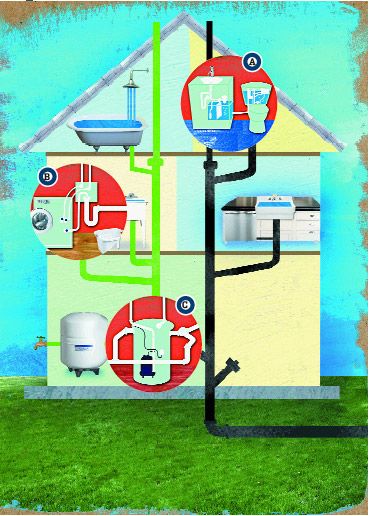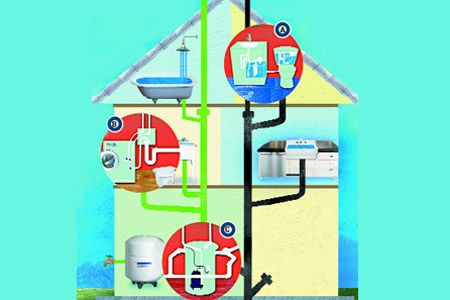
Why not divert shower water to the lawn, instead of sending it to the sewer? Plants don’t mind a little soap and, well, skin cells. And the savings aren’t hard to imagine when you consider that even with all those low-flow fixtures installed, the potable water you lavish on shrubs draws significantly on your fresh-water supply. So does that clean water you tap for flushing, which in some states can be substituted with the effluent from your sink.
Redirecting gray water for such uses isn’t always easy. In fact, because conventional plumbing systems combine gray water with “black” post-toilet-flush water in the same drainpipe, separating them in a code-compliant manner requires an entire parallel wastewater system alongside your existing main sewer line—installed by a professional. But it’s the long-term savings stretched out over the life of your mortgage, years after the retrofit’s paid for, that are so compelling. ReWater Systems manufacturer Steve Bilson projects that a family of four can save anywhere from $300 to $600 annually by diverting gray water just for irrigation. Even in code-happy California, where a system might run you close to $7,000, it’s possible to reduce your use of fresh water so much that a retrofit pays for itself in about 10 years—in less time if you’re in an area where you pay both water and sewer fees. In a home under construction, the installation costs can shrink to less than $600.
Opting for even one gray-water use can make a difference. If you have to choose, “irrigation’s the most cost-effective, and it’s legal in every state,” Bilson says. Since he’s put in roughly 800 systems and was a consultant on California’s gray-water legislation, surely three retrofits he approves of are worth a look.
A. Sink-Fed Toilet Tanks
Flushing toilets with water draining from showers, sinks, and tubs is allowed in International Plumbing Code states (it’s prohibited by the Uniform Plumbing Code in 17 others, mostly in the West). This sink-to-toilet tank hookup, from Water Saver Technologies, is a self-contained system: Source water flows via pump directly to its end use. (Source water from a bathroom sink—not a kitchen one, which is at high risk for bacteria such as E. coli—is recommended.)
B. Laundry-Fed Irrigation
The easiest gray-water source is a washing machine. Its pump is already pulling water out, discharging it into an accessible standpipe that you can extend outside the house. Just take care to strain the water through a sand filter or polyester felt mesh bag, bury irrigating polyethylene pipes 9 inches deep, and keep the discharge far from wells, creeks and streams.
C. Gray-Water Main Line
To reuse gray water throughout your home, you need a whole-house “gray water supply” main line. It resembles the existing main drain but is separated from toilet lines and leads to a surge tank that’s properly vented through the roof. To seperate gray sources from the main, you also need a crawl space or basement foundation for easy access to plumbing.

